Friday Foto: Two Birds
posted 20 September 2013 in Photos. no comments yet
Hello. I’m Gavin Edwards, the public speaker and the New York Times-bestselling author of The Tao of Bill Murray, the ’Scuse Me While I Kiss This Guy series, and Kindness and Wonder: Why Mister Rogers Matters Now More Than Ever. If you’re interested in hiring me, click here for more information.
posted 20 September 2013 in Photos. no comments yet
(New to the countdown? Catch up here.)
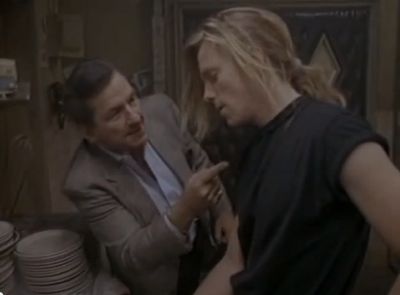 In a busy restaurant kitchen, a hulking blonde dude leans over a sink full of dirty dishes, listening to Poison’s cover of “Rock and Roll All Nite.” He has pulled his hair back in an unsuccessful attempt at a ponytail. A busboy with a neat dark ponytail–a fellow rocker who is doing better fitting into the workplace–drops off some more dishes and says, “Hey, man. Better get jamming. Nick’s on his way back here.”
In a busy restaurant kitchen, a hulking blonde dude leans over a sink full of dirty dishes, listening to Poison’s cover of “Rock and Roll All Nite.” He has pulled his hair back in an unsuccessful attempt at a ponytail. A busboy with a neat dark ponytail–a fellow rocker who is doing better fitting into the workplace–drops off some more dishes and says, “Hey, man. Better get jamming. Nick’s on his way back here.”
Nick, a pugnacious boss in a sports jacket, promptly comes through the swinging kitchen door and flicks off the radio. “Hey, you!” he barks at the dishwasher, pointing at him. “I told you before: I’m paying you to wash dishes, not to listen to that, that rock ’n’ roll.” He gestures at the radio. “I got a whole restaurant full of people out there. You’re moving in two speeds: slow and stop. Now either get your butt in gear or you’re out of here! Get it? Move!”
While the dishwasher doesn’t seem to be doing a particularly efficient job, he also doesn’t have a good workstation–his sink could really use one of those high-power sprayers. He’s got a clean stack of dishes lined up on the right side of the sink–why isn’t anyone coming to take them away? I think we have to conclude that this backlog is actually a high-level management failure on Nick’s part.
As Nick leaves, the dishwasher angrily turns the radio back on. The song has ended and we hear the DJ: “–rockin’ Saturday night. Now for all of you out there slaving on the job, here’s some Poison to get you thinking about those good times!” The dishwasher takes off his apron, throws it down, and kicks open a door (not the door that leads to the restaurant). This works as effectively as if he were entering a wardrobe in search of a hair-metal Narnia: a guitar riff begins, and through the doorway we see Poison onstage. (I long believed that the director built the kitchen set and the Poison set right next to each other on the same soundstage, but on closer examination, I think this is a post-production green-screen effect.)
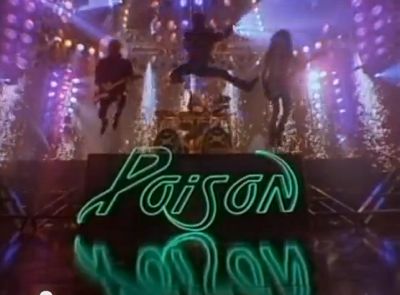 We get instant rock excess, in the form of spotlights, neon-green logos, and the four members of Poison themselves. Their first album, Look What the Cat Dragged In, was pretty much a full-length tribute to girl-group records, complete with “Be My Baby” drums and wedding bells, so it only seemed fair that the members looked like girls themselves. In 1988, for their second record, Open Up and Say… Ahh!, they dialed down the cross-dressing, but the band members lived in the corner of a Venn diagram where “lipstick” and “spandex” and “insane peacock guy fashion” intersected.
We get instant rock excess, in the form of spotlights, neon-green logos, and the four members of Poison themselves. Their first album, Look What the Cat Dragged In, was pretty much a full-length tribute to girl-group records, complete with “Be My Baby” drums and wedding bells, so it only seemed fair that the members looked like girls themselves. In 1988, for their second record, Open Up and Say… Ahh!, they dialed down the cross-dressing, but the band members lived in the corner of a Venn diagram where “lipstick” and “spandex” and “insane peacock guy fashion” intersected.
So we cut between the members, with their hair teased as high as gravity will allow. C.C. DeVille poses with his guitar. Rikki Rockett stands up and twirls his sticks. Showers of fireworks pour down from the lighting rig–in many other videos, this would be the climactic moment, but for Poison, it is only the starting point.
“Oooooeaaahyuh!” Bret Michaels screams as three members of Poison jump off their stage. He does a split on the way down, or at least gestures in the direction of a split. They run forward in slow motion, fireworks cascading behind them. Narrative bookends aside, this is a straight-up performance video, but Poison are determined to fill every split second of it with glitter and insanity. Before there’s a single lyric, they’re hopping around, spinning, and sliding on their knees across the stage.
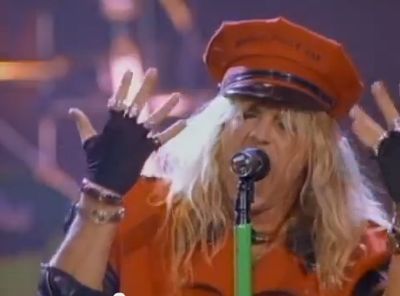 “Now listen,” Michaels sings. “Not a dime, I can’t pay my rent / I can barely make it through the week / Saturday night I’d like to make my girl / But right now I can’t make ends meet.” While he delivers this extended rock ’n’ roll zeugma, the band jumps and spins around, looking young and skinny. Michaels is in a t-shirt and ripped jeans, and has a bright-green microphone stand that matches the Poison logo on the drum riser, and DeVille’s guitar. DeVille himself is in black leather, while bassist Bobby Dall has patterned leggings and an acid-washed denim jacket, and appears to be on a work-exchange loan from the Bangles. Before we even reach the chorus, Michaels is in his second outfit of the video: this one has a red leather vest, black fingerless gloves, and a red military-style cap. It looks like the winning outfit on a Project Runway episode where the assignment was “slutty stewardess.”
“Now listen,” Michaels sings. “Not a dime, I can’t pay my rent / I can barely make it through the week / Saturday night I’d like to make my girl / But right now I can’t make ends meet.” While he delivers this extended rock ’n’ roll zeugma, the band jumps and spins around, looking young and skinny. Michaels is in a t-shirt and ripped jeans, and has a bright-green microphone stand that matches the Poison logo on the drum riser, and DeVille’s guitar. DeVille himself is in black leather, while bassist Bobby Dall has patterned leggings and an acid-washed denim jacket, and appears to be on a work-exchange loan from the Bangles. Before we even reach the chorus, Michaels is in his second outfit of the video: this one has a red leather vest, black fingerless gloves, and a red military-style cap. It looks like the winning outfit on a Project Runway episode where the assignment was “slutty stewardess.”
“If you could hear me think, this is what I’d say,” Michaels sings. Isn’t the whole point of oral communication to let people know what one is thinking? Is he lamenting that he doesn’t have telepathic powers, or just restating the first principles of spoken language?
Before the chorus finishes, we get the third outfit for Michaels: sleeveless black shirt, lots of bracelets, gray fedora. Only seconds later, he introduces his fourth look, which features round sunglasses and a floppy asymmetrical hat that balances on top of his head like a mattress on a bottle of wine.
 The song is a tasty pop-metal lollipop. The band senses that stardom is within reach, and they’re not going to miss out for lack of effort. The three non-drummers do a Temptations-style routine, stepping left in unison, doing a synchronized high kick, and finishing with a pirouette. “Gotta get a break from–” Michaels sings, and then thrusts the microphone forward so DeVille and Dall can lean in and sing “the same-old, same-old.” The fifth outfit for Michaels features a paisley headband.
The song is a tasty pop-metal lollipop. The band senses that stardom is within reach, and they’re not going to miss out for lack of effort. The three non-drummers do a Temptations-style routine, stepping left in unison, doing a synchronized high kick, and finishing with a pirouette. “Gotta get a break from–” Michaels sings, and then thrusts the microphone forward so DeVille and Dall can lean in and sing “the same-old, same-old.” The fifth outfit for Michaels features a paisley headband.
Bridge: Michaels grabs his grey fedora off the neck of DeVille’s guitar. “You see, I raise a toast to all of us who are breaking our backs every day,” he sings, managing to sound completely sincere. “If wanting the good life is such a crime, Lord, then put me away!” He punctuates this sentiment by pointing into the camera, showing off all the jewelry on his right hand, and then throwing his hat at the camera.
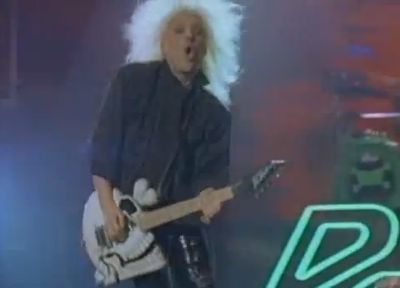 Guitar solo. Lots of quick cuts, many different guitars–but as far as I can see in this video, DeVille can only cross the stage from the audience’s left to their right. Presumably whenever he reaches the right side of the stage and is in danger of falling into the crowd, a roadie picks him up and carries him back to the left so he can start all over again.
Guitar solo. Lots of quick cuts, many different guitars–but as far as I can see in this video, DeVille can only cross the stage from the audience’s left to their right. Presumably whenever he reaches the right side of the stage and is in danger of falling into the crowd, a roadie picks him up and carries him back to the left so he can start all over again.
“Guitar,” Michaels announces, proving that he has hung around rock bands long enough to differentiate one instrument from another.
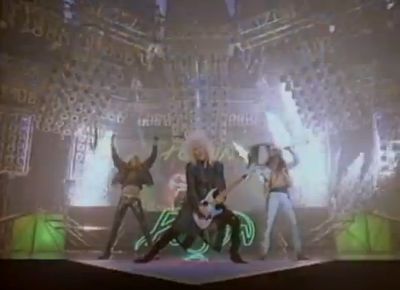 The big finale: DeVille plays the song’s central riff. The camera pulls back to show that behind him Michaels is pumping his microphone stand in the air and Dall is following suit with his bass. The drums make a whooshing sound–I suspect that producer Tom Werman flipped the tape and we’re hearing them played backwards. More fireworks go off–they’re synchronized to the drums, although the calisthenics of Michaels and Dall are not. Cut to DeVille, playing a pink guitar on top of the lighting rig. Spotlights wheel around, the camera spins, and metallic confetti rains down upon the band.
The big finale: DeVille plays the song’s central riff. The camera pulls back to show that behind him Michaels is pumping his microphone stand in the air and Dall is following suit with his bass. The drums make a whooshing sound–I suspect that producer Tom Werman flipped the tape and we’re hearing them played backwards. More fireworks go off–they’re synchronized to the drums, although the calisthenics of Michaels and Dall are not. Cut to DeVille, playing a pink guitar on top of the lighting rig. Spotlights wheel around, the camera spins, and metallic confetti rains down upon the band.
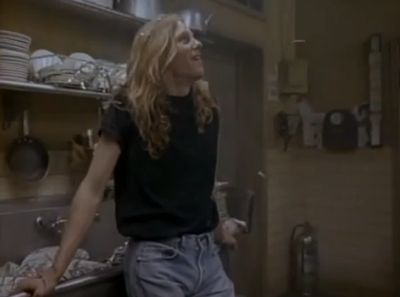 The song ends with a flurry of fast cuts and the band taking a bow. We cut back to the kitchen, where the dishwasher is leaning against the sink. The power of Poison hasn’t cleaned the dishes for him, but he looks up at the ceiling, blissed out, as some of the metallic confetti rains down upon him. “Now don’t you feel better?” the DJ says. “Nothing like a little rock ’n’ roll to get the juices flowing, and speaking of juice, we have a juicy weekend coming up, highs in the eighties, lows in the sixties–personally, I prefer the highs.”
The song ends with a flurry of fast cuts and the band taking a bow. We cut back to the kitchen, where the dishwasher is leaning against the sink. The power of Poison hasn’t cleaned the dishes for him, but he looks up at the ceiling, blissed out, as some of the metallic confetti rains down upon him. “Now don’t you feel better?” the DJ says. “Nothing like a little rock ’n’ roll to get the juices flowing, and speaking of juice, we have a juicy weekend coming up, highs in the eighties, lows in the sixties–personally, I prefer the highs.”
Nick returns into the kitchen. “Hey, you!” he complains. Then he notices the confetti floating in the air. He looks perplexed, and wanders off. Our dishwasher hero never says a word the entire video: his boss and the DJ speak to him, but Poison speak for him.
“Nothin’ But a Good Time” made it to #6 on the Billboard singles chart. (Poison’s followup single was “Fallen Angel,” seen previously on our countdown.) You can watch it here.
posted 19 September 2013 in 1988. 16 comments
 Public Enemy are my favorite rap act of the past 25 years, but somehow I had never seen them live until this past weekend, when I was lucky enough to catch their set at the Riot Fest in Chicago (my photo, from stage right, is Flavor Flav on the left and Chuck D on the right). It was as awesome as one would hope for, and a cool mix of classic material and newer tracks. And Flavor Flav closed the show with an impassioned speech about racism–he’s a clown, yes, but he’s not a dumb guy. A few things, outside the music, that struck me:
Public Enemy are my favorite rap act of the past 25 years, but somehow I had never seen them live until this past weekend, when I was lucky enough to catch their set at the Riot Fest in Chicago (my photo, from stage right, is Flavor Flav on the left and Chuck D on the right). It was as awesome as one would hope for, and a cool mix of classic material and newer tracks. And Flavor Flav closed the show with an impassioned speech about racism–he’s a clown, yes, but he’s not a dumb guy. A few things, outside the music, that struck me:
1. Chuck D’s habit of wielding his microphone with both hands like he’s a batter stepping up to the plate, taking some practice swings before digging in against a pitcher.
2. Flavor Flav’s electric sneakers, with blinking lights.
3. When the S1Ws drill onstage, it now seems less like a paramilitary gesture and more like a step show in fatigues.
4. Terminator X has retired, and according to Wikipedia, is running an ostrich farm in North Carolina. (His replacement, DJ Lord, did a great job cutting up “Smells Like Teen Spirit.”)
5. I was on the ground, just to the side of the stage, and people in my area kept passing their cameras up to whoever was hanging out on stage right so they could take some photos closer to the action. The various members of the PE entourage did this cheerfully–including Professor Griff.
posted 18 September 2013 in Tasty Bits. no comments yet
Consider Billy Joel’s antimaterialistic #17 single “Movin’ Out (Anthony’s Song),” specifically Sergeant O’Leary, who is trading in his Chevy for a Cadillac-ack-ack-ack-ack-ack:
And if he can’t drive with a broken back / At least he can polish the fenders
Let’s leave aside the question of how Sergeant O’Leary is walking the beat or working as a bartender with a snapped spine–maybe the point is that all this toil is going to destroy him. But polishing car fenders involves a fair bit of physical movement–how’s O’Leary going to do that with a broken back?
posted 26 August 2013 in Tasty Bits. no comments yet
posted 23 August 2013 in Photos. no comments yet
(New to the countdown? Catch up here.)
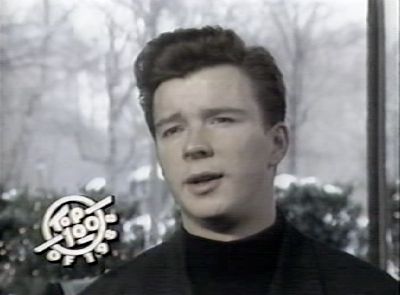 Rick Astley holds forth, in a thick northern English accent, in front of a glass window; behind him, we can see New York City in wintertime. “I don’t like being in front of cameras,” he says, looking straight into the camera, and laughs uncomfortably. “So I find that quite hard, you know. As I said before, I’m quite a shy person in a lot of ways. So to bop around in front of a camera, I find very hard, you know. I find doing TV’s very hard. Singing in front of a real audience, I don’t find that a problem. I feel confident then. So it’s been quite a difficult thing to get used to.”
Rick Astley holds forth, in a thick northern English accent, in front of a glass window; behind him, we can see New York City in wintertime. “I don’t like being in front of cameras,” he says, looking straight into the camera, and laughs uncomfortably. “So I find that quite hard, you know. As I said before, I’m quite a shy person in a lot of ways. So to bop around in front of a camera, I find very hard, you know. I find doing TV’s very hard. Singing in front of a real audience, I don’t find that a problem. I feel confident then. So it’s been quite a difficult thing to get used to.”
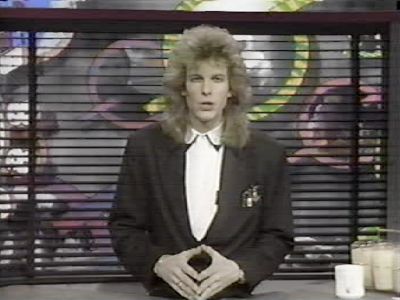 We cut to Adam Curry, who calls Astley “Slick Rick” and confidently declares that since the time of that interview, Astley has grown accustomed to cameras. Pressing his fingertips together, Curry recaps Astley’s success: “in 1987, his hit ‘Never Gonna Give You Up’ was the hit of the year in the UK and in Europe, and it also went to number one in the States in 1988.” He does not mention that two decades later, it would be huger than ever (69 million YouTube plays and counting, at this writing). I choose to believe that this is not because Adam Curry didn’t know the future, but because he didn’t want to blow our minds by explaining the Web, YouTube, and Rickrolling.
We cut to Adam Curry, who calls Astley “Slick Rick” and confidently declares that since the time of that interview, Astley has grown accustomed to cameras. Pressing his fingertips together, Curry recaps Astley’s success: “in 1987, his hit ‘Never Gonna Give You Up’ was the hit of the year in the UK and in Europe, and it also went to number one in the States in 1988.” He does not mention that two decades later, it would be huger than ever (69 million YouTube plays and counting, at this writing). I choose to believe that this is not because Adam Curry didn’t know the future, but because he didn’t want to blow our minds by explaining the Web, YouTube, and Rickrolling.
We begin the video with some electronic drumbeats and meet Mr. Rick Astley, who is dancing, or doing his best simulation of it: he shimmies in place, shifting his weight from one foot to the other. Spoiler alert: this is basically what he does for the entire video. He’s dressed like he’s meeting a girlfriend’s family for dinner, in a striped polo shirt and a dark jacket. He doesn’t know what to do with his hands, so he keeps opening and closing them.
 We cut to Rick outside at night, in front of a stone wall with two archways. He’s wearing a black turtleneck and a white trenchcoat, and is doing the exact same almost-a-dance. There’s also a platinum-blonde girl in a sleeveless black shirt, who is dancing, marginally more gracefully than Rick.
We cut to Rick outside at night, in front of a stone wall with two archways. He’s wearing a black turtleneck and a white trenchcoat, and is doing the exact same almost-a-dance. There’s also a platinum-blonde girl in a sleeveless black shirt, who is dancing, marginally more gracefully than Rick.
Still in the instrumental intro, we get a third look for Rick: outside in the sunshine, in front of a chain-link fence, with a blue work shirt buttoned all the way up and a pair of sunglasses. These are the many moods of Rick, I suppose. His British pallor makes him look like a twerpy vampire, but for some reason, he doesn’t explode into flames. He keeps doing his weight-shifting routine. There’s another platinum-blonde girl, this one in a sleeveless white shirt, and she spins around.
“You’re no stranger to love,” Rick sings, and sweet mother of Barry White, this 22-year-old who looks 12 has a baritone coming out of his throat that sounds like it must have been surgically implanted. This was the essential experience of watching a Rick Astley video: the incongruity of a hapless, vaguely handsome British kid having one of the biggest voices in pop music.
Rick pledges his fealty to his love interest–“a full commitment’s what I’m thinking of”–while we cut between his two outdoor looks (with a dash of the platinum blondes for variety). The camera is moving around as fast as it can, swooping past Rick in an effort to give him some extra energy. Then we hit the chorus and return to the striped polo look. Rick is indoors, singing on a stage in what looks like a cavernous restaurant. The joint is devoid of customers: the idea is presumably that he’s practicing his act (with the two blondes serving as his backup dancers) before the evening rush, not that every paying customer has bolted down their food and fled.
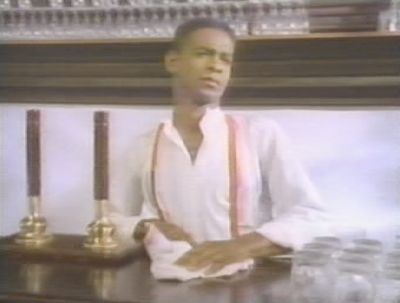 The restaurant’s bartender is wiping down the bar. He’s wearing a white shirt and red suspenders, he’s handsome, and he’s black. This proves to be important, as he will act out a brief drama of a crossover hit: first he looks up skeptically at Rick; then he nods approvingly while tossing a drinking glass in the air, catching it, and polishing it; then he starts dancing behind the bar; and finally he starts really rocking out, doing spins and jumping up so he can do a split and touch his toes in midair. Since it’s hard to imagine anyone whiter than Rick Astley, this performance plays as a cross-racial seal of approval. It also helps to have somebody in this video who can really dance, since it is basically a disco tune.
The restaurant’s bartender is wiping down the bar. He’s wearing a white shirt and red suspenders, he’s handsome, and he’s black. This proves to be important, as he will act out a brief drama of a crossover hit: first he looks up skeptically at Rick; then he nods approvingly while tossing a drinking glass in the air, catching it, and polishing it; then he starts dancing behind the bar; and finally he starts really rocking out, doing spins and jumping up so he can do a split and touch his toes in midair. Since it’s hard to imagine anyone whiter than Rick Astley, this performance plays as a cross-racial seal of approval. It also helps to have somebody in this video who can really dance, since it is basically a disco tune.
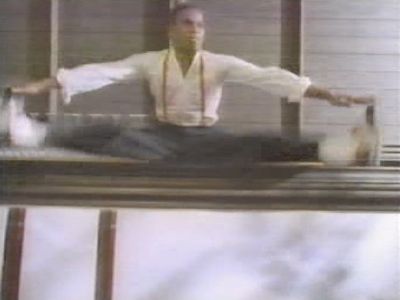 The song is the heavily synthesized work of British production team Stock-Aitken-Waterman. In the UK, they were oppressively successful from 1986 to 1990 with their assembly-line hits, but many of their flagship artists, such as Kylie Minogue and Jason Donovan, never really cracked the States. Rick Astley was a drummer-turned-singer in a soul band who worked as a tape operator and “tea boy” (British for “gofer”) in the Stock-Aitken-Waterman studio. Even before Rickrolling, this song worked people’s nerves: witness Nick Lowe‘s 1990 track “All Men Are Liars,” featuring the lyric “Do you remember Rick Astley? / He had a big fat hit that was ghastly.”
The song is the heavily synthesized work of British production team Stock-Aitken-Waterman. In the UK, they were oppressively successful from 1986 to 1990 with their assembly-line hits, but many of their flagship artists, such as Kylie Minogue and Jason Donovan, never really cracked the States. Rick Astley was a drummer-turned-singer in a soul band who worked as a tape operator and “tea boy” (British for “gofer”) in the Stock-Aitken-Waterman studio. Even before Rickrolling, this song worked people’s nerves: witness Nick Lowe‘s 1990 track “All Men Are Liars,” featuring the lyric “Do you remember Rick Astley? / He had a big fat hit that was ghastly.”
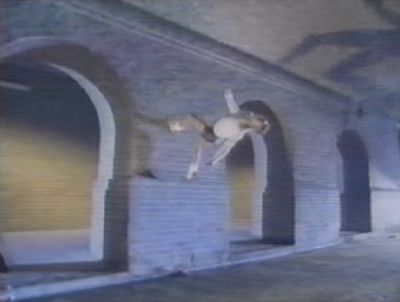 The bartender runs in place, throws his rag in the air, and somersaults over the bar. He is running neck and neck with Tom Cruise’s Cocktail performance for the “Craziest Bartender of 1988” medal. The blondes keep on looking over their shoulders at the camera. Another man enters the video; he’s even blonder than the girls. Now and then, the editor cuts to a brief clip of Rick’s shadow. The bartender has come outside so he can jump against the chain link fence, bouncing off it in an acrobatic fashion. Super-blonde guy turns out to be a pretty good dancer, swiveling his body and spinning on his knees. The bartender runs up the stone wall and flips his body into a somersault, which is a real Matrix move without the benefit of a special-effects budget. Man, I hope whoever played the bartender parlayed this video into a West End show or an Olympics medal or something.
The bartender runs in place, throws his rag in the air, and somersaults over the bar. He is running neck and neck with Tom Cruise’s Cocktail performance for the “Craziest Bartender of 1988” medal. The blondes keep on looking over their shoulders at the camera. Another man enters the video; he’s even blonder than the girls. Now and then, the editor cuts to a brief clip of Rick’s shadow. The bartender has come outside so he can jump against the chain link fence, bouncing off it in an acrobatic fashion. Super-blonde guy turns out to be a pretty good dancer, swiveling his body and spinning on his knees. The bartender runs up the stone wall and flips his body into a somersault, which is a real Matrix move without the benefit of a special-effects budget. Man, I hope whoever played the bartender parlayed this video into a West End show or an Olympics medal or something.
 We cut between Rick’s various looks as he keeps repeating the chorus. (“Never gonna” is heard fully forty times in this song). Rick has a big grin on his face, and seems totally unconnected to the song emotionally. This is the track’s big flaw: when the chorus was misheard as “Now I’m gonna give you up,” as it frequently was, it seemed just as plausible a lyric. Rick’s vocal performance didn’t give you any emotional cues as to whether he wanted to pick out silverware together or to ditch you by the side of the road with some loose change for the bus.
We cut between Rick’s various looks as he keeps repeating the chorus. (“Never gonna” is heard fully forty times in this song). Rick has a big grin on his face, and seems totally unconnected to the song emotionally. This is the track’s big flaw: when the chorus was misheard as “Now I’m gonna give you up,” as it frequently was, it seemed just as plausible a lyric. Rick’s vocal performance didn’t give you any emotional cues as to whether he wanted to pick out silverware together or to ditch you by the side of the road with some loose change for the bus.
“Never Gonna Give You Up,” as Adam Curry mentioned, hit number one–for two weeks in the US and five weeks in the UK. (It was followed later in 1988 by the soundalike number-one single “Together Forever,” which we covered early in this countdown.) You can watch it here.
posted 19 August 2013 in 1988. 9 comments
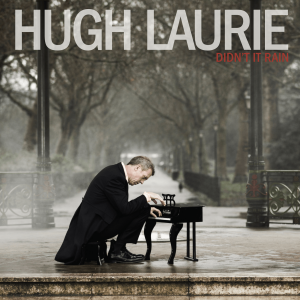 Hugh Laurie has released his second album, Didn’t It Rain: another disc of New Orleans jazz and blues, a genre that he loves and proves to be a surprisingly fluent performer in. It’s been almost two years since I wrote a profile of Laurie for The New York Times Magazine (and almost seven years since I interviewed him for Rolling Stone and he advanced the opinion, mildly controversial then and a well-worn verity now, that TV in the modern era was operating at a higher level than movies). Three incidental but memorable experiences from reporting the Laurie article for the Times: (1) On my way to Heathrow, done with my London reporting, I took a car in the opposite direction so I could return to the Natural History Museum and tape the elevator message, on a hunch that I might need it (read the opening paragraphs of the article if that doesn’t make sense). When the Times factchecker flagged that passage as something that would need double-checking, I just cackled with delight. (2) I got to trade emails with both Laurie and Stephen Fry, who are pretty much the world’s most charming correspondents. (3) I saw Laurie perform at a small LA club, joined for the encores by Tom Jones, who decided on the spot to teach the band some Jerry Lee Lewis songs.
Hugh Laurie has released his second album, Didn’t It Rain: another disc of New Orleans jazz and blues, a genre that he loves and proves to be a surprisingly fluent performer in. It’s been almost two years since I wrote a profile of Laurie for The New York Times Magazine (and almost seven years since I interviewed him for Rolling Stone and he advanced the opinion, mildly controversial then and a well-worn verity now, that TV in the modern era was operating at a higher level than movies). Three incidental but memorable experiences from reporting the Laurie article for the Times: (1) On my way to Heathrow, done with my London reporting, I took a car in the opposite direction so I could return to the Natural History Museum and tape the elevator message, on a hunch that I might need it (read the opening paragraphs of the article if that doesn’t make sense). When the Times factchecker flagged that passage as something that would need double-checking, I just cackled with delight. (2) I got to trade emails with both Laurie and Stephen Fry, who are pretty much the world’s most charming correspondents. (3) I saw Laurie perform at a small LA club, joined for the encores by Tom Jones, who decided on the spot to teach the band some Jerry Lee Lewis songs.
posted 13 August 2013 in Articles, News. no comments yet
1. Dave Grohl (Nirvana/Foo Fighters)
2. Keith Strickland (B-52’s)
3. J. Mascis (Dinosaur Jr.)
4. Patrick Wilson (Weezer)
5. Don Henley (Eagles)
(I’m thinking of people who started out principally behind the drum kit and then moved up front with a guitar, not somebody like Lenny Kravitz, who’s been a multinstrumentalist pretty much from day one. Who else qualifies?)
posted 9 August 2013 in Tasty Bits. 4 comments
 A decal spotted on a locked door in the New York City subway system (this past May).
A decal spotted on a locked door in the New York City subway system (this past May).
posted 2 August 2013 in Photos. no comments yet
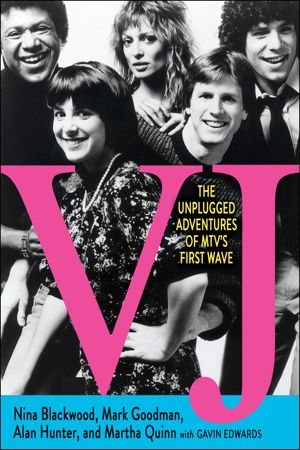 32 years ago today, everyone who worked at MTV got into a yellow school bus and went across the river to New Jersey to watch the launch of a new 24-hour music channel. Why New Jersey? The network wasn’t on Manhattan cable yet. If you want to read more about the launch, the earliest videos, and the possible fishnet wardrobe of some VJs that night, then you should celebrate the day by picking up VJ, the book I had the pleasure of writing with original MTV VJs Nina Blackwood, Mark Goodman, Alan Hunter, and Martha Quinn.
32 years ago today, everyone who worked at MTV got into a yellow school bus and went across the river to New Jersey to watch the launch of a new 24-hour music channel. Why New Jersey? The network wasn’t on Manhattan cable yet. If you want to read more about the launch, the earliest videos, and the possible fishnet wardrobe of some VJs that night, then you should celebrate the day by picking up VJ, the book I had the pleasure of writing with original MTV VJs Nina Blackwood, Mark Goodman, Alan Hunter, and Martha Quinn.
“That night, after the launch,” Mark said, “I thought about how MTV was on forever. That was in my head all night: ‘Now we have to feed the beast.’ Over and over and over again, and it’s never, ever, ever, ever, going to stop. Shit. How are we going to do that?”
Now let’s work on making August 1st a national holiday: we can call it MTV When It Played Videos Day.
posted 1 August 2013 in Buy My Stuff, Tasty Bits. no comments yet